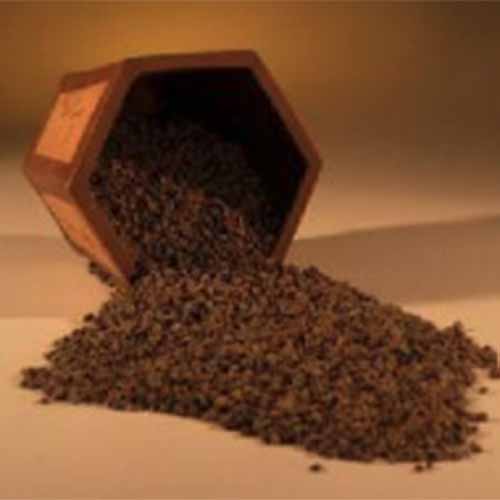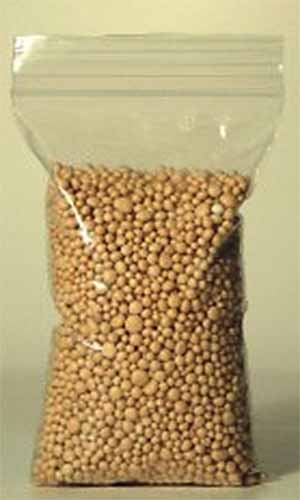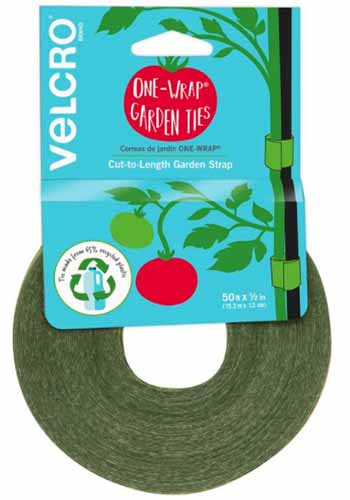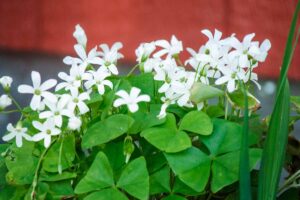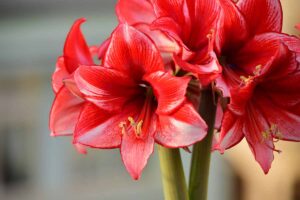If you’re looking to dip your toe into the world of bonsai but you don’t want to start with anything too difficult, dracaena plants are about to become your new best friends.
Most bonsai needs to be kept outdoors and requires a careful balance of water, bright light, and regular feedings.
Dracaena, on the other hand, can live inside all year long, and is perfectly happy in low light. It won’t turn up its toes if you fall a bit behind on the old watering schedule, and feeding is a biannual prospect.
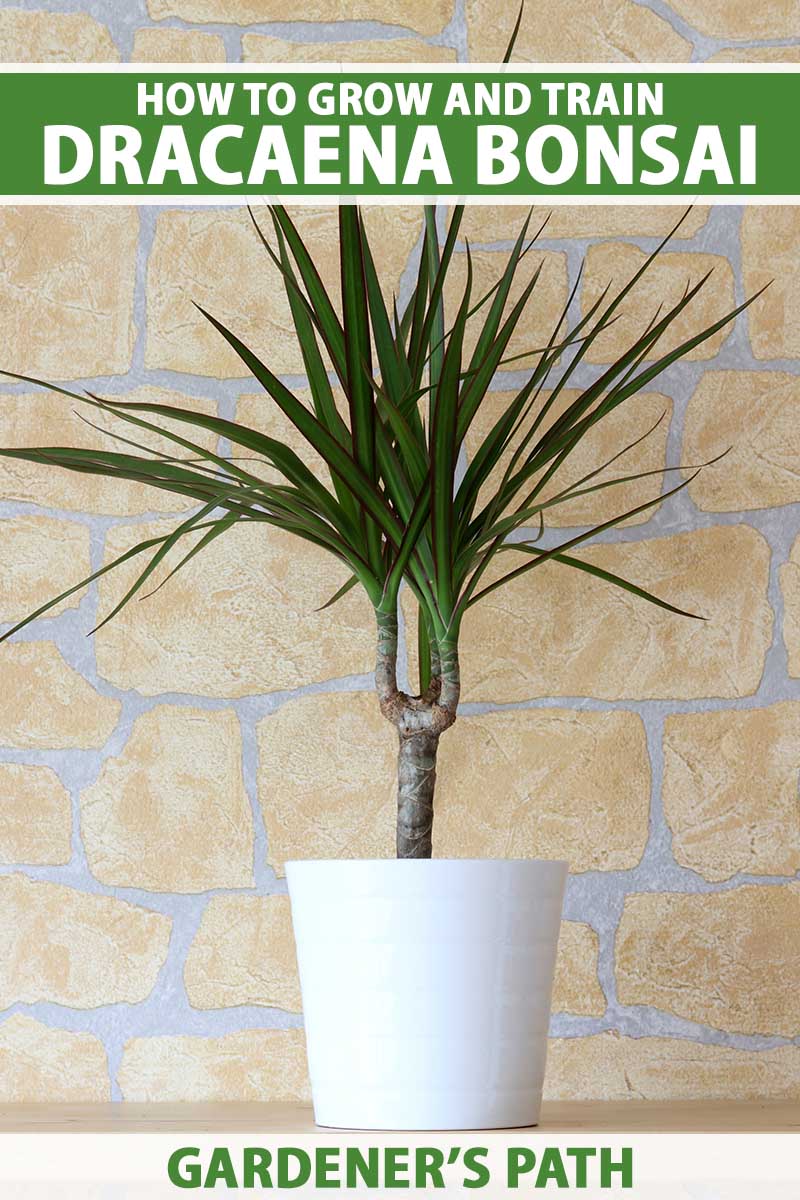
We link to vendors to help you find relevant products. If you buy from one of our links, we may earn a commission.
To put it simply, dracaena makes learning the art of bonsai easy.
Here’s what you can expect in this guide:
What You’ll Learn
If you’ve grown a dragon tree before, then you know what’s involved.
If not, you might want to check out our growing guide to help you get your footing. We also have a beginner’s guide to starting with bonsai if you are looking for a bit more info.
All set? Then let’s start our journey.
Dracaena as Bonsai
Dracaena is perfect if you dream of caring for an indoor bonsai that can grow in low light.
It isn’t one of the “traditional” species that experts use, partially because it has such large leaves. Most traditional bonsai have small leaves, which make it so they appear to be miniature trees.
The large leaves of dragon trees shatter this illusion, but they’re still an excellent option for those who want an easy-care tree that can live inside year-round.
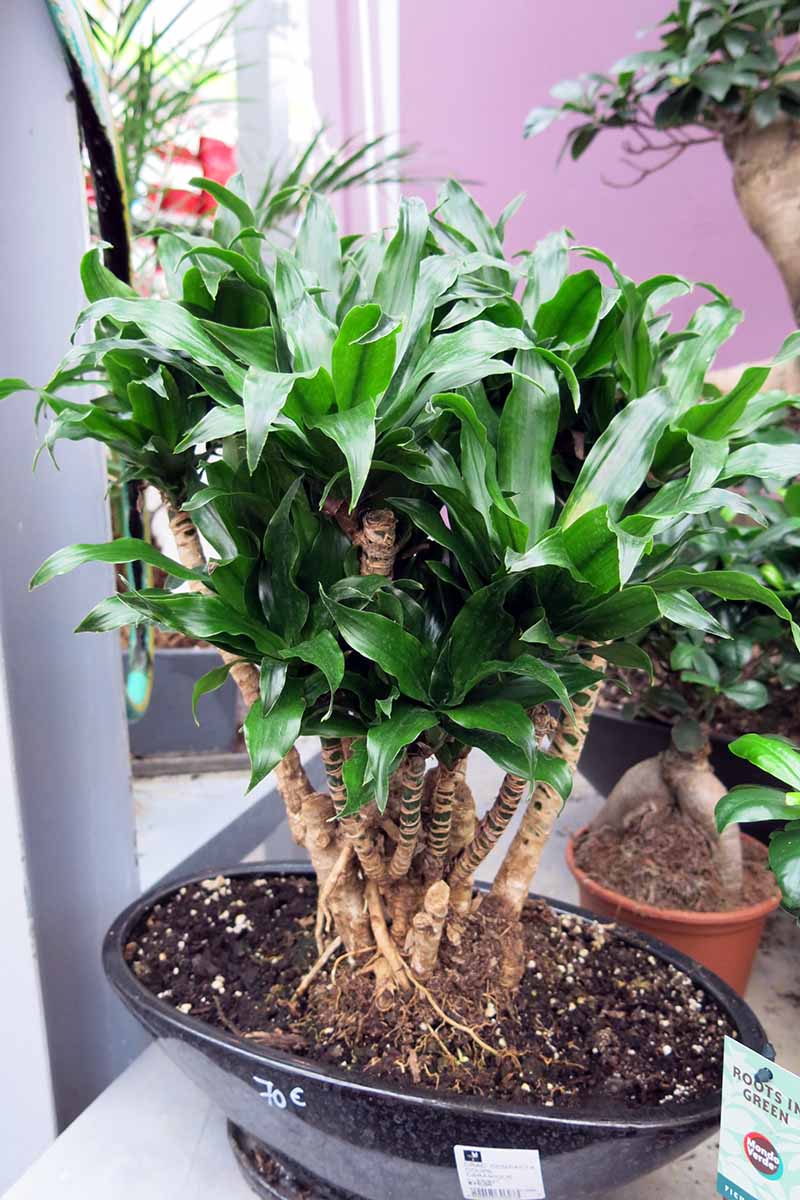
Dragon trees lend themselves well to training as bonsai because they like it when their roots are bound a little bit. They can also withstand a bit of drought – which is ideal if you are somewhat, shall we say, forgetful about watering.
You might be wondering where the name “dracaena” comes from. It’s modern Latin and derived from the Greek name drakaina, denoting a mythical female serpent or dragon. The plant has blood-red sap and a crown of spiky flowers, making it appear dragon-like.
In fact, the blood-red resin is so vibrant that it has been used in the paint industry.
These plants can live for a long time, which makes them particularly suitable for bonsai. One of the oldest dragon trees in the world grows in Tenerife, the largest of the Canary Islands, coming in at around 500 years old.
Planting and Care
So you brought your dracaena home, and now it’s time to repot it.
Even if you purchased a pre-started specimen in a container, you will still want to remove the existing soil and replace it with your own fresh stuff.
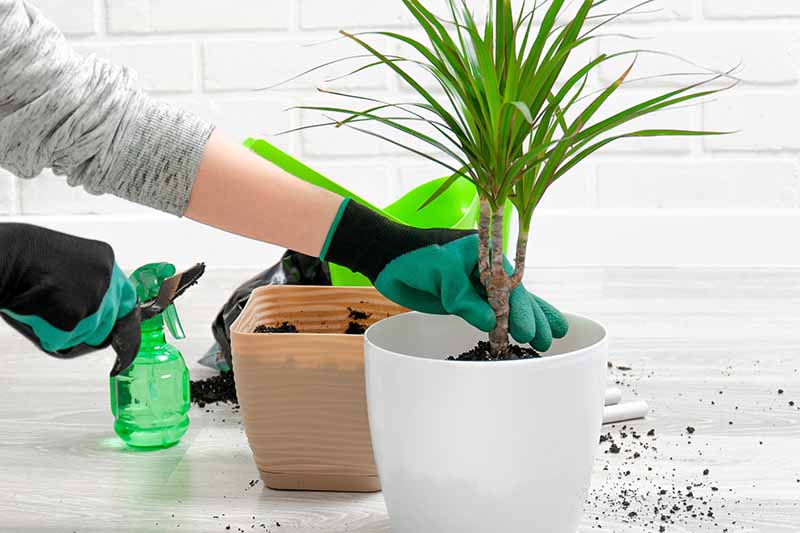
The first step is to take the plant out of its existing container and brush away as much of the soil as you can. Be sure to remove any glued-on rocks that may have been put in the top of the container with the plant.
Trim away any dead or mushy roots with a clean pair of shears. You might also need to shorten some of the roots in order to ensure that it will fit in your selected container.
If you’re reusing a container, clean it with a mixture of one part bleach to nine parts water. Then, place the plant in the clean container and fill in around it with fresh substrate.
Dracaena requires a different type of substrate than a traditional species used in bonsai would. Instead, you want to select a substrate that’s suitable for growing tropical plants.
Bonsai Boy has a tropical mix made just for indoor bonsai.
Now, add some water to settle the substrate and give your traumatized plant a drink.
Once you’ve planted your new addition, place it in an area where it will receive bright, indirect light. Allow the soil to dry out between watering, but don’t let it sit in dry soil for too long. Your plant will suffer anything more than a few days with dry soil.
Feeding should happen twice a year, with the first application in the spring, and the second in the summer. Don’t fertilize in the fall or winter when your plant’s growth slows.
Any fertilizer formulated for bonsai will do. These fertilizers are made to slowly release nutrients into the substrate to keep your plant happy for several months.
Slow Release Fertilizer Pellets
Bonsai Boy carries four-ounce bags of slow-release pellets.
Be sure to wipe the leaves occasionally with a damp cloth to remove any dust.
Shaping and Pruning
When you bring your dragon plant home, it will either already be trained into shape, or you will need to train it yourself.
Here’s where the fun part happens.
Dracaena normally grows with one stalk and a tuft of leaves at the top. While you can’t create a complex canopy of branches as you can with some other species, you can cut the top off of a dragon tree and it will send out new shoots.
That means you can leave it as-is with a single stem and tuft, or cut it and grow several new stems, each with its own tuft of leaves.

To top your plant, use a clean pair of secateurs and make a straight cut at the height you prefer. Keep your plant in a warm spot with indirect light and water as you normally would. You should begin to see new growth emerging within a few weeks.
Once the stem forms new tufts, you can allow these to grow, or you also can top them to encourage more branching.
One of the really exciting elements of dracaenas is that you can twist, braid, or turn the stems into interesting shapes to suit your creative vision.
I’ve seen twisting trunks, ones that form an “S” shape, and even specimens that zigzag. If you add more plants to the same container, you can twist or braid the stems around each other.
Just keep in mind that in traditional bonsai, the apex of the tree ends directly above the base of the plant. If you decide to twist and bend your trunks, try to make sure they end directly above the roots.
Then again, bonsai is an art, so have at it and get creative!
To create a braid, start with a plant that has three, four, five, or six stems. Gently twist or braid them in a way that looks pleasing to you. You can go for a more formal look and create a traditional three-part braid, or twist the stems randomly to make them look more natural.
If necessary, secure the stems at the top under the foliage with garden ties. You may also need to secure the stems lower down the trunks if they don’t want to stay put.
I like Velcro’s Garden Ties because they stay secure and they’re easy to use and adjust, if necessary. Sound good to you?
Home Depot carries 50-foot lengths. That may sound like a lot, but you’ll no doubt find lots of ways to use this handy stuff.
To create bends and twists, gently wrap a young, pliable trunk around a dowel or piece of wood and fasten it with ties. You’ll need to do this gradually, over several weeks or months.
Don’t try to create a dramatic shape all at once, because you run the risk of breaking the trunk. If it feels like it is resisting, stop!
Soaking the stem (not the roots) in water for 30 minutes can help to make it a bit more pliable. After soaking, allow the stem to harden into shape.
You don’t need to prune dracaena necessarily, but be sure to trim away any yellowing or dead leaves. You can also trim to keep its height in check as desired.
Repotting
Dracaena has a lot going for it as a bonsai. It can grow in low light, is able to stay indoors year-round, and doesn’t require a lot of maintenance.
But there’s just one exception: These plants grow quickly, and they’ll need to be repotted or have their roots trimmed much more frequently than most other plants used traditionally to create this botanical art.
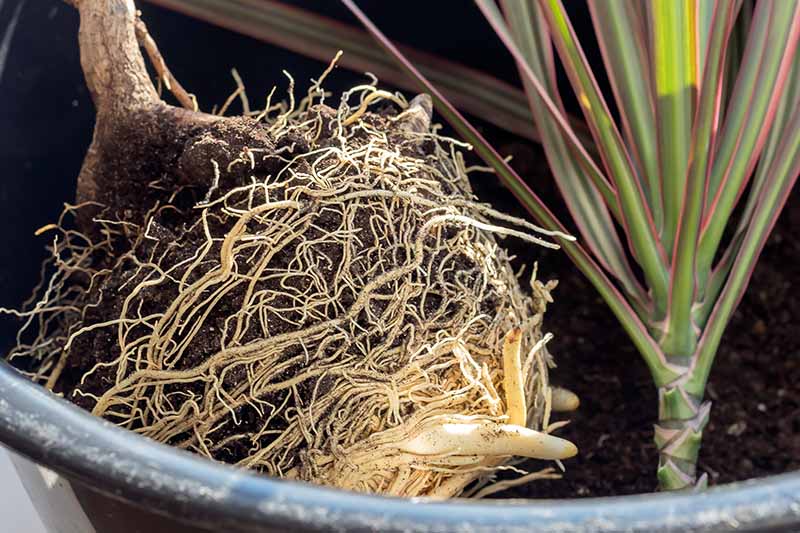
The process is the same as with any other species used in bonsai.
You’ll need to remove the tree from its pot, knock or brush away as much soil as possible, and then trim back the roots so that they fit inside the pot without being so crowded that they press up against the sides of the container.
By constraining the roots, you are helping the plant to stay a manageable size. Repot in the same potting mixture you used initially.
Species and Cultivars to Select
Dracaena is actually the name of a genus that includes dozens of species, of which a handful are commonly grown as houseplants.
D. fragrans, D. deremensis, D. marginata, D. sanderiana, and D. surculosa are the most common, and any plant from these species can be made into bonsai.
Marginata plants make particularly good specimens and there are several different cultivars you can choose from, including ‘Colorama,’ ‘Tarzan,’ and ‘Tricolor.’
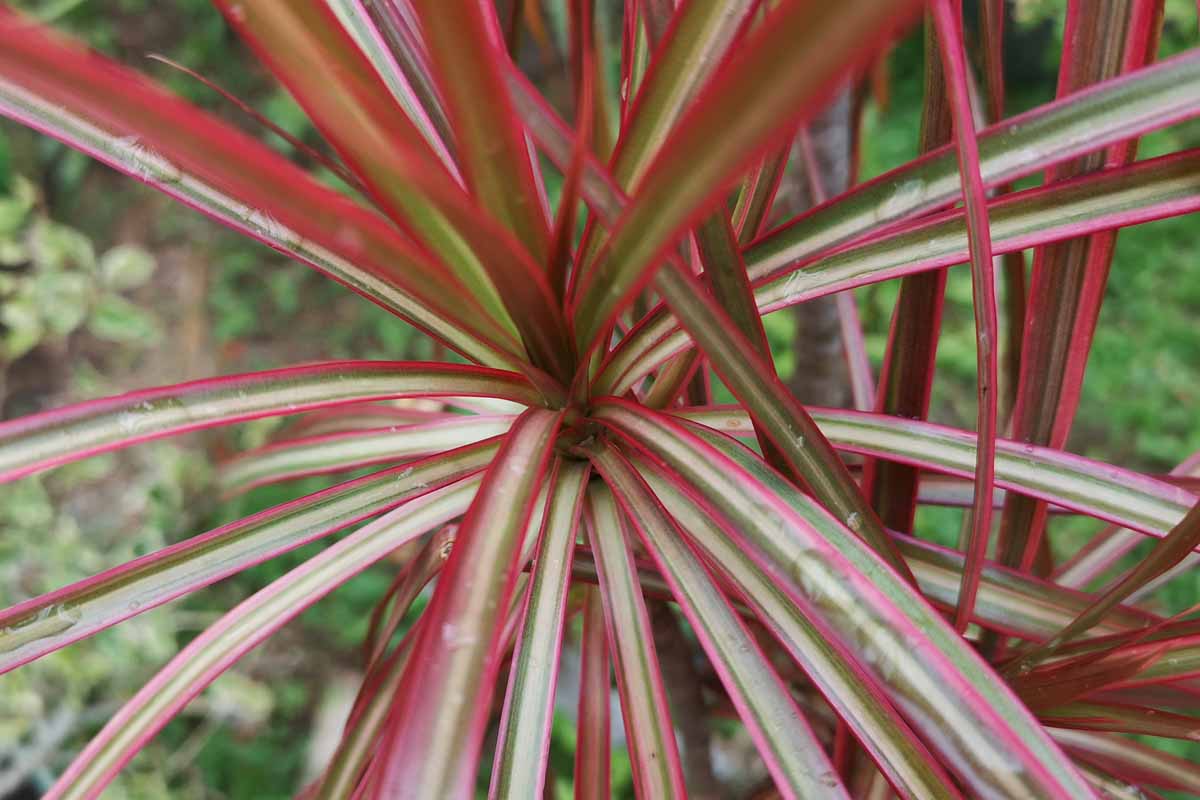
‘Tarzan’ has exceptionally spiky, thick, and compact leaves, which look particularly nice on a petite container plant.
‘Colorama’ stands out with its reddish-pink striped foliage, while ‘Tricolor’ has yellow, green, and pink leaves.
Managing Pests and Disease
Any pest or disease that can impact dracaena houseplants can harm your bonsai.
Aphids, mealybugs, scale, and spider mites are all pests to watch for. Keep an eye out for soft rot and leaf spots as well.
Our guide has more details on spotting and stopping these issues.
Perfect for Beginners
For a plant that can create such a dramatic display, dracaena doesn’t ask for a lot.
That makes it ideal if you’re just starting your journey with the art form, and even experienced practitioners can learn something from this low-fuss wonder.
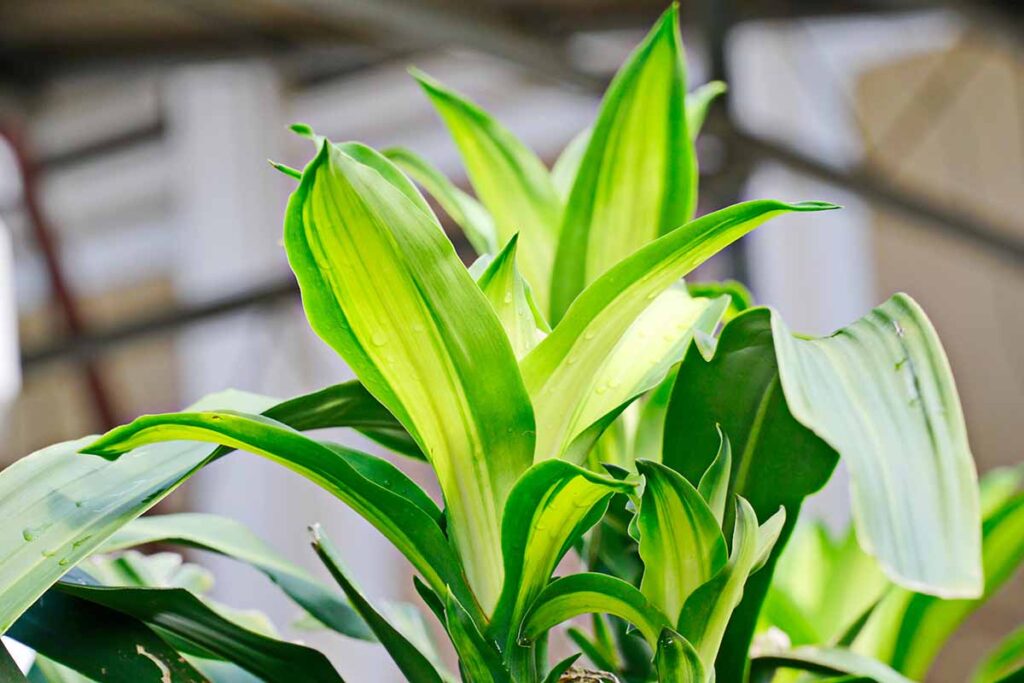
What shape do you plan to give your new addition to your indoor space? Are you opting for a tall pot or a wide one? Tell us all about your big plans in the comments below!
If this guide gave you the confidence you needed to grow your dracaena bonsai, you might want to expand your knowledge of the art by checking these guides next:
